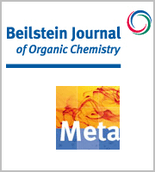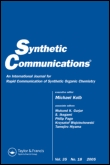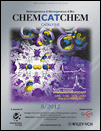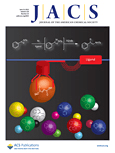
ACS Organic & Inorganic Au
Scope & Guideline
Connecting Researchers for a Sustainable Future in Chemistry
Introduction
Aims and Scopes
- Organic Synthesis and Methodology:
The journal extensively covers developments in synthetic methodologies, including novel reactions, catalytic processes, and mechanistic studies, to enhance organic synthesis. - Inorganic Chemistry and Coordination Complexes:
Research on coordination chemistry, metal complexes, and their applications in catalysis and materials science is a core focus, showcasing new findings in the reactivity and properties of inorganic compounds. - Electrochemistry and Electrocatalysis:
The journal highlights advancements in electrochemical methodologies, including electrocatalysis, electrochemical synthesis, and studies on electron transfer processes. - Photochemistry and Photoredox Catalysis:
There is a significant emphasis on photochemical processes, including visible-light-mediated reactions and the development of photoredox catalysts for organic transformations. - Materials Chemistry and Nanotechnology:
Research related to the synthesis, characterization, and application of novel materials, particularly in the context of catalysis and energy conversion, is well-represented in the journal. - Sustainable Chemistry and Green Processes:
The journal encourages research that focuses on sustainability, including methods for chemical upcycling, solvent-free reactions, and the development of environmentally friendly synthetic routes.
Trending and Emerging
- Electrochemical Methods in Synthesis:
There is a growing trend towards the application of electrochemical methods for organic synthesis, including electrocatalysis and electrochemical transformations, which are gaining prominence due to their efficiency and sustainability. - Photoredox Catalysis:
The use of photoredox catalysis has surged, with numerous studies focusing on visible-light-driven reactions, showcasing its potential for sustainable and innovative synthetic strategies. - Sustainable and Green Chemistry Approaches:
An increase in research dedicated to sustainable chemistry practices, such as chemical upcycling and environmentally friendly synthesis, reflects a broader commitment to addressing global environmental challenges. - Mechanochemistry:
Mechanochemical approaches to organic and inorganic synthesis are emerging as a valuable area of research, emphasizing solvent-free and energy-efficient methodologies. - Advanced Materials and Nanocatalysts:
There is a notable rise in studies concerning advanced materials and nanocatalysts, particularly in catalysis and energy applications, indicating a trend towards interdisciplinary research that bridges chemistry with materials science.
Declining or Waning
- Traditional Organic Synthesis Techniques:
There appears to be a decrease in publications centered around conventional organic synthesis techniques, as researchers increasingly explore more innovative and efficient methods. - Metal-Mediated Reactions without Novel Catalysts:
Research focusing solely on traditional metal-mediated reactions without the introduction of novel catalysts or methodologies is declining, indicating a shift towards more advanced catalytic systems. - Basic Coordination Chemistry Studies:
There is a diminishing emphasis on purely descriptive studies of coordination complexes without practical applications or insights into their reactivity and utility in catalysis. - Classical Organometallic Chemistry:
The journal has seen fewer publications concentrating on classical organometallic chemistry, suggesting a trend towards integrating organometallic studies with broader applications in materials science or catalysis.
Similar Journals

Beilstein Journal of Organic Chemistry
Connecting researchers to shape the future of organic chemistry.The Beilstein Journal of Organic Chemistry, published by the renowned BEILSTEIN-INSTITUT, stands as a pivotal platform for advancing the field of organic chemistry since its inception in 2005. With its commitment to Open Access publishing, this journal enables global readership and collaboration, fostering the dissemination of high-quality research. Operating from Germany, the journal has carved out a significant reputation, currently holding a Q2 ranking in the Organic Chemistry category, with impressive Scopus rankings placing it at #91 out of 211 in the field, achieving a 57th percentile. The Beilstein Journal is dedicated to publishing cutting-edge findings that span the breadth of organic chemistry, including synthetic methodologies, catalysis, and material sciences, making it an essential resource for researchers, professionals, and students looking to stay at the forefront of organic chemistry advancements. With a vision to enhance collaboration and knowledge sharing within the scientific community, the journal plays a vital role in shaping the future of organic chemistry research.

SYNTHETIC COMMUNICATIONS
Empowering Researchers with Key Insights in SynthesisSynthetic Communications, published by Taylor & Francis Inc, stands as a pivotal resource in the field of organic chemistry since its inception in 1971. With an ISSN of 0039-7911 and an E-ISSN of 1532-2432, this journal has established a commendable reputation, holding a Q3 ranking in organic chemistry by 2023, reflecting its contributions to the discipline and positioning it within the 50th percentile according to Scopus rankings. Targeted towards researchers, professionals, and students alike, Synthetic Communications aims to disseminate significant advancements in synthetic methodologies and reactions, facilitating the exchange of innovative ideas and enhancing collaborative efforts in the scientific community. Although not an open-access journal, it offers a wealth of valuable research content that is crucial for anyone dedicated to pushing the boundaries of organic chemistry.

Catalysts
Elevating the Science of Catalysis through CollaborationCatalysts is a leading academic journal in the field of catalysis, published by MDPI since 2011 and well-regarded for its commitment to open access publishing. Based in Switzerland, this journal delivers innovative research and reviews that span various aspects of catalysis, from heterogeneous and homogeneous catalysis to the development of novel catalytic systems. With a commendable impact factor and a notable Q2 ranking in both Catalysis and Physical and Theoretical Chemistry categories, Catalysts plays a critical role in advancing the scientific discourse in these fields. The open-access model ensures that all research articles are readily accessible to researchers and professionals worldwide, fostering collaboration and accessibility to high-quality scientific literature. As the journal continues to publish cutting-edge studies up to its convergence in 2024, it remains an essential resource for anyone involved in catalysis research, from seasoned professionals to emerging scholars.

Asian Journal of Organic Chemistry
Championing quality and impact in organic chemistry studies.Asian Journal of Organic Chemistry, published by WILEY-V C H VERLAG GMBH, stands as a pivotal platform in the realm of organic chemistry, catering to researchers and professionals eager to share their contributions to the field. With an ISSN of 2193-5807 and E-ISSN of 2193-5815, this journal spans a commendable convergence from 2012 to 2024, featuring a notable impact factor highlighted by its Q2 ranking in the 2023 Organic Chemistry category. Positioned at rank #94 out of 211 in Scopus, the journal emphasizes the importance of quality research and innovation in organic chemistry. The lack of open access enhances the journal's selectivity, ensuring only the most rigorous and impactful studies are published. Serving as a vital resource for scholars, students, and practitioners alike, the Asian Journal of Organic Chemistry fosters the dissemination of knowledge, advances academic dialogue, and reinforces the pivotal role of organic chemistry in scientific advancement.

ChemCatChem
Advancing Catalysis and Chemistry for a Brighter Tomorrow.ChemCatChem is a leading international journal published by WILEY-V C H VERLAG GMBH that has been making significant contributions to the fields of catalysis, inorganic and organic chemistry, as well as physical and theoretical chemistry since its inception in 2009. With an established reputation for excellence, this journal holds commendable rankings in various categories, including Q1 in Inorganic Chemistry and Q1 in Organic Chemistry, demonstrating its pivotal role in advancing scientific knowledge and innovation. Notably, it has achieved a high Scopus ranking, securing 10th place out of 79 in Inorganic Chemistry, among others, showcasing its influence and quality. Although open access options are not available, the journal offers cutting-edge research articles, reviews, and insights that are vital for researchers, professionals, and students aiming to stay at the forefront of chemical science. With its address rooted in Weinheim, Germany, and convergence projected to continue until 2024, ChemCatChem remains a dynamic platform for disseminating vital advancements within the chemical community.

Nature Synthesis
Exploring Novel Pathways in ChemistryNature Synthesis, published by SpringerNature, is a premier peer-reviewed journal dedicated to advancing the field of synthesis in chemistry and materials science. With an impressive impact factor and categorized in the Q1 quartile for Chemistry (miscellaneous), Inorganic Chemistry, Materials Chemistry, and Organic Chemistry, it ranks prominently among its peers, reflecting its high-quality research output and relevance.
This journal provides a platform for researchers, professionals, and students to publish innovative synthesis methodologies, novel materials, and interdisciplinary approaches that push the boundaries of chemistry. Operating under an Open Access model, it ensures that research is widely accessible, fostering collaboration and engagement across the global scientific community.
Situated in the United Kingdom, Nature Synthesis is committed to contributing to the scientific discourse from 2022 to 2024, and beyond, as it continues to highlight significant advancements across chemistry domains.

RUSSIAN JOURNAL OF GENERAL CHEMISTRY
Bridging Disciplines Through Rigorous Chemistry InsightsThe Russian Journal of General Chemistry is a prominent scholarly publication dedicated to advancing the field of general chemistry. Published by MAIK NAUKA/INTERPERIODICA/SPRINGER, this journal contributes significantly to the global chemistry landscape, offering a platform for researchers and professionals to share their latest findings and methodologies. With an ISSN of 1070-3632 and an E-ISSN of 1608-3350, it has established itself as a resource for high-quality research articles since its inception in 1996. Though currently indexed in the Q4 category for chemistry (miscellaneous) and ranking #299 out of 408 in general chemistry according to Scopus, the journal remains an important venue for academic contributions that bridge gaps in traditional chemical disciplines. Desiring to cater to a diverse range of interests within chemistry, the journal actively encourages submissions that reflect significant scientific achievements, innovations, and collaborative studies. Although the journal does not currently offer open access, its role in disseminating crucial chemical research cannot be overstated. Researchers and students alike will find valuable insights and rigorous scientific discourse in its pages.

Journal of the American Chemical Society
Catalyzing Innovation in Chemical ScienceJournal of the American Chemical Society (JACS), published by the American Chemical Society, stands as a pivotal publication in the field of chemistry, facilitating the dissemination of significant research findings since its inception in 1879. With an impressive impact factor and esteemed rankings placing it in the Q1 quartile across various categories—including Biochemistry, Catalysis, and Colloid and Surface Chemistry—JACS continues to serve as a vital resource for scientists, professionals, and students alike. Researchers choose JACS for its rigorous peer-review process, ensuring high-quality content that shapes the landscape of modern chemistry. The journal's extensive scope encompasses pivotal advancements and innovative methodologies, reflecting the evolving dynamics of chemical research. With access options being traditional subscription-based, it remains crucial for institutions and individuals to engage with its latest issues to stay at the forefront of chemical science advancement.

Chemistry-An Asian Journal
Highlighting the Impact of Chemistry in Asia and Beyond.Chemistry-An Asian Journal is a premier academic publication in the field of chemistry, published by WILEY-V C H VERLAG GMBH in the United Kingdom. With an impressive track record since its inception in 2006, this journal has established itself as a leading platform for high-quality research, effectively bridging the gap between fundamental and applied chemistry. The journal is currently ranked in the Q2 category for Biochemistry and Q1 in both Chemistry (miscellaneous) and Organic Chemistry as of 2023, reflecting its significant impact and relevance in the scientific community. According to Scopus metrics, it stands at a commendable rank of #92 out of 408 in General Chemistry, showcasing its influence and reach among researchers. Although not an open-access journal, it offers a wealth of subscription options, allowing access to cutting-edge research articles and reviews that cater to both seasoned professionals and new entrants to the field. By publishing innovative findings and fostering discussions on contemporary issues in chemistry, Chemistry-An Asian Journal remains a vital resource for advancing knowledge and facilitating collaboration among scientists globally.

ORGANIC LETTERS
Catalyzing Knowledge in Organic Chemistry ExcellenceOrganic Letters is a leading peer-reviewed journal dedicated to the rapid dissemination of research in the field of organic chemistry. Published by the American Chemical Society, this esteemed journal has been an invaluable resource for researchers and professionals since its inception in 1999, featuring research articles that contribute significantly to the understanding of organic synthesis and related disciplines. With its impressive impact factor, it is currently ranked in the top quartile (Q1) across multiple categories, including Biochemistry, Organic Chemistry, and Physical and Theoretical Chemistry, showcasing its influence in the scientific community. The journal's commitment to quality is underscored by its high rankings in Scopus, placing it among the top tier of journals in its categories. While not an open-access journal, Organic Letters offers exceptional access options for institutions and individuals seeking cutting-edge research. As it continues to evolve towards its convergence year of 2024, it remains the go-to publication for innovative findings and methodologies in organic chemistry.